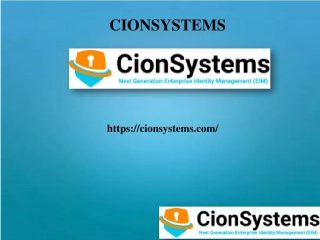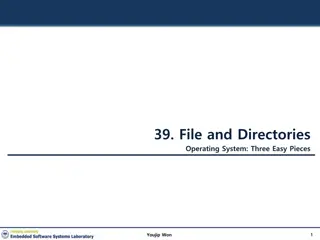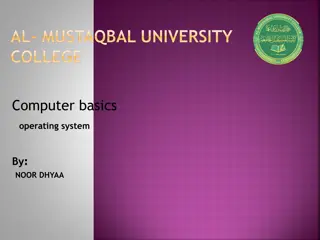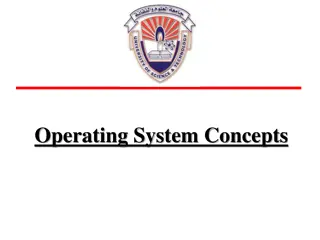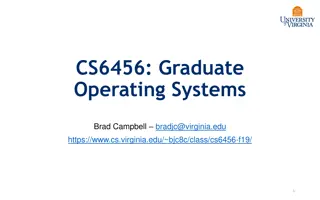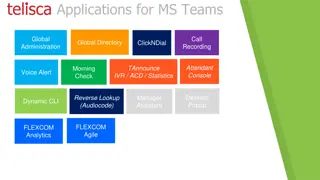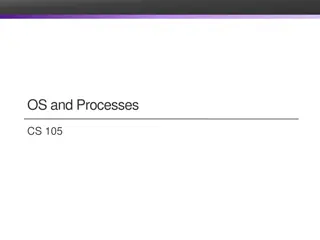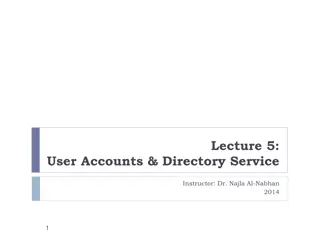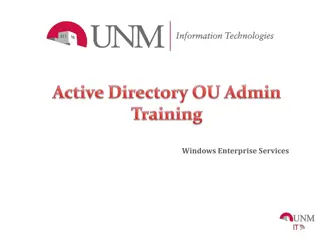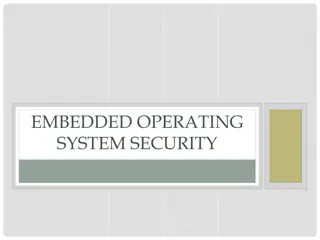Understanding Directory Structures in Operating Systems
Directory structures play a crucial role in operating systems, organizing files, and supporting essential operations like file search, creation, deletion, listing, and traversal. This content explores single-level and two-level directory structures, addressing their benefits and limitations in managing file names and user data effectively.
Download Presentation

Please find below an Image/Link to download the presentation.
The content on the website is provided AS IS for your information and personal use only. It may not be sold, licensed, or shared on other websites without obtaining consent from the author. Download presentation by click this link. If you encounter any issues during the download, it is possible that the publisher has removed the file from their server.
E N D
Presentation Transcript
Operating Systems Operating Systems Chapter 3 By By: Lecturer : Lecturer Raoof Raoof Talal Talal
3.3.2 Directory Overview The directory can be viewed as a symbol table that translates file names into their directory entries. If we take such a view, we see that the directory itself can be organized in many ways. When considering a particular directory structure, we need to keep in mind the operations that are to be performed on a directory:
Searchfor a file: Create a file: Delete a file: List a directory: Rename a file: Traverse the file system: We may wish to access every directory and every file within a directory structure. For reliability, it is a good idea to save the contents and structure of the entire file system at regular intervals. Often, we do this by copying all files to magnetic tape. This technique provides a backup copy in case of system failure.
3.3.3 Single-Level Directory The simplest directory structure is the single-level directory. All files are contained in the same directory, which is easy to support and understand A single-level directory has significant limitations, however, when the number of files increases or when the system has more than one user. Since all files are in the same directory, they must have unique names. If two users call their data file test, then the unique-name rule is violated.
3.3.4 Two-Level Directory As we have seen, a single-level directory often leads to confusion of file names among different users. The standard solution is to create a separate directory for each user. In the two-level directory structure, each user has own user file directory (UFD). The UFDs have similar structures, but each lists only the files of a single user.
When a user job starts or a user logs in, the system's master file directory (MFD) is searched. The MFD is indexed by user name or account number, and each entry points to the UFD for that user . When a user refers to a particular file, only his own UFD is searched. Thus, different users may have files with the same name, as long as all the file names within each UFD are unique.
Although the two-level directory structure solves the name-collision problem, it still has disadvantages. This structure effectively isolates one user from another. Isolation is an advantage when the users are completely independent but is a disadvantage when the users want to cooperate on some task and to access one another's files.
3.3.5 Tree-Structured Directories Once we have seen how to view a two-level directory as a two-level tree, the natural generalization is to extend the directory structure to a tree of arbitrary height (Figure 3.8). This generalization allows users to create their own subdirectories and to organize their files accordingly. A tree is the most common directory structure. The tree has a root directory, and every file in the system has a uniquepath name. In normal use, each process has a current directory. The current directory should contain most of the files that are of current interest to the process. A directory (or subdirectory) contains a set of files or subdirectories. All directories have the same internal format.
Path names can be of two types: absolute and relative. An absolute path name begins at the root and follows a path down to the specified file, giving the directory names on the path. A relative path name defines a path from the current directory. For example, in the tree-structured file system of Figure 3.8, if the current directory is root/spell/mail, then the relative path name prt/first refers to the same file as does the root/spcll/mail/prt/first. absolute path name
3.3.6 Acyclic-Graph Directories Consider two programmers who are working on a joint project. The files associated with that project can be stored in a subdirectory. But since both programmers are equally responsible for the project, both want the subdirectory to be in their own directories. The common subdirectory should be shared. Ashared directory or file will exist in the file system in two (or more) places at once.
Acyclic graphthat is, a graph with no cycles allows directories to share subdirectories and files . The same file or subdirectory may be in two different directories. It is important to note that a shared file (or directory) is not the same as two copies of the file. With two copies, each programmer can view the copy rather than the original, but if one programmer changes the file, the changes will not appear in the other's copy.
With a shared file, only one actual file exists, so any changes made by one person are immediately visible to the other. Sharing is particularly important for subdirectories; a new file created by one person will automatically appears in all the shared subdirectories. Several problems must be considered carefully. A file may now have multiple absolute path names. Another problem involves deletion. When can the space allocated to a shared file be de-allocated and reused? One possibility is to remove the file whenever anyone deletes it, but this action may leave dangling pointers to the now-nonexistent file.
3.3.7 General Graph Directory A serious problem with using an acyclic-graph structure is ensuring that there are no cycles. When we add links to an existing tree-structured directory, the tree structure is destroyed, resulting in a simple graph structure (Figure 3.10).
3.4 Protection When information is stored in a computer system, we want to keep it safe from physical damage (reliability) and improper access (protection). Protection can be provided in many ways. For a small single-user system, we might provide protection by physically removing the floppy disks and locking them in a desk drawer or file cabinet. In a multiuser system, however, other mechanisms are needed.
3.4.1 Types of Access Access is permitted or denied depending on several factors, one of which is the type of access requested. Several different types of operations may be controlled: Read: Read from the file. Write: Write or rewrite the file. Execute: Load the file into memory and execute it. Append: Write new information at the end of the file. Delete: Delete the file and tree its space for possible reuse. List: List the name and attributes of the file. Other operations, such as renaming, copying, and editing the file, may also be controlled.
3.4.2 Access Control The most common approach to the protection problem is to make access dependent on the identity of the user. Different users may need different types of access to a file or directory. The most general scheme to implement identity dependent access is to associate with each file and directory an access-control list (ACL) specifying user names and the types of access allowed for each user. When a user requests access to a particular file, the operating system checks the access list associated with that file. If that user is listed for the requested access, the access is allowed. Otherwise, a protection violation occurs, and the user job is denied access to the file. The main problem with access lists is their length. If we want to allow everyone to read a file, we must list all users with read access.
To condense the length of the access-control list, many systems recognize three classifications of users in connection with each file: Group: A set of users who are sharing the file and need similar access is a group, or work group. Owner: The user who created the file is the owner. Universe: All other users in the system constitute the universe. The most common recent approach is to combine access-control lists with the more general owner, group, and universe access control scheme just described.
3.4.3 Other Protection Approaches Another approach to the protection problem is to associate a password with each file. Just as access to the computer system is often controlled by a password, access to each file can be controlled in the same way. If the passwords are chosen randomly and changed often, this scheme may be effective in limiting access to a file.



